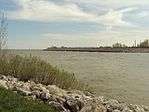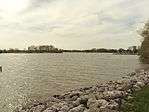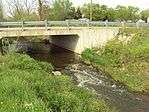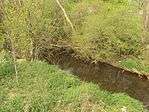Sandy Creek (Michigan)
| Sandy Creek | |
| River | |
 Sandy Creek looking west from the North Dixie Highway bridge in Frenchtown Charter Township | |
| Country | United States |
|---|---|
| State | Michigan |
| Region | Monroe County |
| Tributaries | |
| - left | Little Sandy Creek |
| Source | |
| - location | London Township |
| - elevation | 663 ft (202 m) |
| - coordinates | 42°01′48″N 83°35′31″W / 42.03000°N 83.59194°W |
| Mouth | Lake Erie |
| - location | Sterling State Park / Detroit Beach, Frenchtown Charter Township |
| - elevation | 571 ft (174 m) |
| - coordinates | 41°55′30″N 83°20′02″W / 41.92500°N 83.33389°WCoordinates: 41°55′30″N 83°20′02″W / 41.92500°N 83.33389°W |
| Length | 18.5 mi (30 km) |
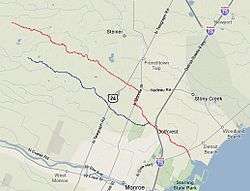 Sandy Creek (red) and Little Sandy Creek (blue) in Monroe County, Michigan | |
Sandy Creek is an 18.5-mile-long (29.8 km)[1] creek located entirely within Monroe County, Michigan. The creek rises in London Township in the north-central portion of the county and flows southeast into Lake Erie at Sterling State Park on the south side of Detroit Beach in Frenchtown Charter Township. Along the shores of Sandy Creek was one of the earliest French settlements in the area, known as the Sandy Creek Settlement, which existed from approximately 1780–1813 before being abandoned after the Battle of Frenchtown during the War of 1812.
Geography
Aside from its disproportionately large mouth at over 100 feet (30 meters), the creek is very narrow. It is roughly 15–20 feet (4.5–6 m) wide as it passes near its end along Detroit Beach. Before that, it is roughly 5–10 feet (1.5–3 m) wide and can easily be walked or leaped across. Its depth fluctuates relatively high during periods of heavy rainfall, although never to the point where the creek floods. Near the mouth, the creek reaches a depth of roughly 15 feet (4.5 m), but after that, the creek never reaches more than three feet (0.9 m) deep. The creek has a very low discharge and often freezes throughout much of the winter. While the creek is referred to as Sandy Creek, it is actually quite rocky— even rockier than the much larger and longer Stony Creek, which runs parallel about a mile north of Sandy Creek. Common fauna of Sandy Creek include crayfish, pumpkinseed, and carp, although most fishes are found near the mouth and in Lake Erie. Much of the creek after a few hundred yards inland is too shallow to accommodate large fish populations.
Its largest tributary, Little Sandy Creek, rises just about a mile south of the main branch and both flow approximately parallel to one another until merging about two miles before the mouth just before Interstate 75. Sandy Creek has numerous unnamed tributaries. Along with passing under I-75, Sandy Creek travels under North Dixie Highway, North Monroe Street, and U.S. Highway 24 (North Telegraph Road). Neither the creek nor any of its tributaries actually pass through the city limits of Monroe. The sources of Sandy Creek and Little Sandy Creek are indistinguishable, as the area is heavily farmed, and water from numerous artificial irrigation ditches and canals contributes to the creek's origins in the north central portion of the county. Sandy Creek is also the name of a short road that runs parallel to the creek near its ending by Lake Erie. It is also the name of a golf course, in which the creeks runs through, near the creek's beginning far inland.[2]
Sandy Creek Settlement
Sandy Creek has historical significance in the region. Along its banks near Lake Erie was one of the earliest European settlements in the area, known as the Sandy Creek Settlement. It was founded just north of Frenchtown, which was settled slightly earlier just south along the banks of the River Raisin. Frenchtown (with some portions later incorporated as the city of Monroe in 1817) was settled by the French in as early as 1784.[3] Like Frenchtown, the Sandy Creek Settlement was a small area of land given to early French settlers by the Potawatomi Native Americans. The small settlement, which grew to only a few dozen inhabitants, was abandoned a few decades later during the War of 1812 after the American Army's catastrophic defeat at the Battle of Frenchtown (also known as the Battle of the River Raisin or the River Raisin Massacre).
The Sandy Creek Settlement was marked near the small bridge on North Dixie Highway with one of many historic markers found throughout the county.[4] However, when the bridge was reconstructed and widened to include a turning lane for East Hurd Road in 2002–2003, the historic marker was moved to Sterling State Park. The historical marker reads:
- Joseph Porlier Benec, Sandy Creek's first settler, was granted a tract of land here by the Pottawatomie Indians, August 3, 1780. By the time of the War of 1812, sixteen homes lined the banks of the creek. Retreating Indians swept through the settlement after the defeat of the British and Indians at the first Battle of the River Raisin, January 18, 1813. Angered by the pro-American remarks of Jean Solo and Rene LaBeau, these Indians shot them. Labeau's frightened young children ran two and a half miles to the River Raisin, seeking the protection of the American Army. The Americans ordered the Sandy Creek settlement abandoned and it never completely rebuilt.[5]
The marker's reference to the "first" Battle of the River Raisin took place on January 18, 1813, in which the American forces defeated the British and Native American alliance. Angered by their defeat, the British and Native Americans counterattacked the unsuspecting American forces four days later on January 22 in the same location along the River Raisin. Many of the Americans were injured during the earlier battle and were unable to retreat; almost 400 Americans were killed— the worst defeat the Americans suffered during the entire war. During this counterattack, the Native Americans also ransacked the Sandy Creek Settlement, forcing its abandonment. Today, the "second" Battle of the River Raisin on January 22, 1813 is commonly referred to as the Battle of Frenchtown. Today, the site of the massacre is part of the River Raisin National Battlefield Park on the shores of the River Raisin, while the lesser-known history of the Sandy Creek Settlement has fallen into obscurity.
Gallery
References
- ↑ U.S. Geological Survey. National Hydrography Dataset high-resolution flowline data. The National Map, accessed May 19, 2011
- ↑ http://www.sandycreekgolf.com/
- ↑ http://www.ci.monroe.mi.us/About_Settlers.cfm
- ↑ http://monroe.lib.mi.us/eresearch/recommended_sites/history/local_history_markers.htm
- ↑ http://www.hmdb.org/marker.asp?MarkerID=27245&Print=1
| Wikimedia Commons has media related to Sandy Creek (Michigan). |
